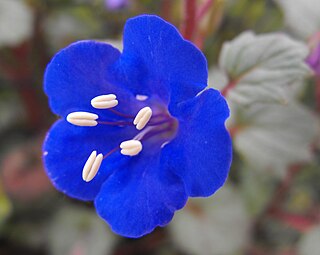
Phacelia campanularia is a species of flowering plant in the borage family, Boraginaceae, known by the common names desertbells, desert bluebells, California-bluebell, desert scorpionweed, and desert Canterbury bells. Its true native range is within the borders of California, in the Mojave and Sonoran Deserts, but it is commonly cultivated as an ornamental plant and it can be found growing elsewhere as an introduced species.

Cerastium glomeratum is a species of flowering plant in the family Caryophyllaceae known by the common names sticky mouse-ear chickweed and clammy chickweed. It is native to Europe, Macaronesia to Assam but is known on most continents as an introduced species. It grows in many types of habitat. The blooming period is February, March, April, and May.

Lathyrus hirsutus is a species of wild pea known by several common names, including Caley pea, singletary pea, hairy vetchling, and Austrian winter pea. It is native to Europe, North Africa, and much of Asia, and it is known from other continents, including North America, as an introduced species. This is an annual herb producing a winged stem and leaves each made up of two leaflike leaflets with a branching, coiled tendril. The inflorescence holds one or two pink, blue, or bicolored pea flowers each 1 to 1.5 centimeters wide. The fruit is a dehiscent legume pod covered in hairs with each hair growing from a minute bulbous base. The rest of the plant is generally hairless.

Alyssum alyssoides is a species of flowering plant in the mustard family known by several common names, including pale madwort and yellow alyssum. It is native to Eurasia, but it can be found throughout much of the temperate world as an introduced species and sometimes a common weed. For example, it has been noted as a weed in the western United States. It often appears in arable fields, sandy tracks, pits, and docks.

Anoda cristata is a species of flowering plant in the mallow family known by many common names, including spurred anoda, crested anoda, and violettas. It is native to North and South America. It is known throughout the rest of the Americas as well as Australia as an introduced species and often a noxious weed. It has been found as a weed in Belgium. Naturally, it is often found near streams, in moist meadows, and in disturbed areas.
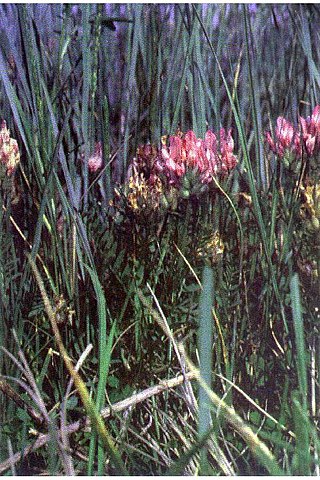
Astragalus agrestis is a species of milkvetch known by the common names purple milkvetch, purple loco, and field milkvetch. It is native to much of western and northern North America from most of Canada to the southwestern United States, as well as eastern Asia. It grows in vernally moist areas such as meadows, and is often found in sagebrush.

Ceanothus sanguineus is a species of shrub in the family Rhamnaceae known by the common name redstem ceanothus. It is native to western North America from British Columbia to Montana to far northern California; it is also known from Michigan. It grows in temperate coniferous forest habitat in forest openings amidst the conifers. This is an erect shrub approaching 3 meters in maximum height. Its stem is red to purple in color, its woody parts green and hairless when new. The deciduous leaves are alternately arranged and up to about 10 centimeters long. They are thin, light green, oval, and generally edged with glandular teeth. The undersides are sometimes hairy. The inflorescence is a cluster of white flowers up to about 12 centimeters long. The fruit is a three-lobed smooth capsule about 4 millimeters long. This shrub is an important food plant for wild ungulates such as the Rocky Mountain Elk, it is browsed eagerly by many types of livestock, and the seed is consumed by many types of animals.

Cytisus multiflorus is a species of legume known by the common names white broom, white spanishbroom and Portuguese broom.
Erodium brachycarpum is a species of flowering plant in the geranium family known by the common names hairy-pitted stork's-bill and shortfruit stork's bill. It is native to southern Europe but it is known elsewhere as an introduced species and often a weed, such as the west coast of the United States where it is widespread in California and Oregon.
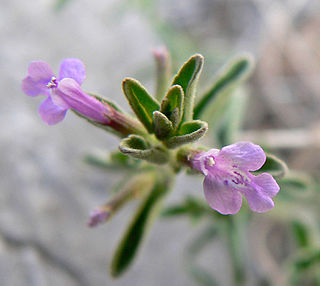
Hedeoma drummondii is a species of flowering plant in the mint family known by the common name Drummond's false pennyroyal. It is native to western North America, where it is distributed mainly in the United States west of the Mississippi River and adjacent Mexico. This is a hairy perennial herb with an erect mintlike form up to 45 centimeters tall. The oppositely arranged paired leaves are linear to narrowly oval in shape, pointed, and up to about a centimeter long. The leaves have a strong sweet mint scent when crushed. The herb tastes like peppermint and is used as a minty flavoring in parts of Mexico. The inflorescence arises from the axils of these leaf pairs, bearing three to seven flowers each between one and two centimeters in length on short pedicels. The flowers are generally light to deep lavender with some white markings. The fruit is a waxy, mucilaginous nutlet.

Lathyrus sphaericus is a species of wild pea known by the common names grass pea and round-seeded vetchling. It is native to Eurasia and much of Africa, and it is known on other continents as an introduced species. It can grow in many types of habitat, including disturbed areas. This is an annual herb producing a slender stem and bearing leaves each made up of two long, narrow, grasslike leaflets up to 6 centimeters long and a coiling, climbing tendril. The inflorescence is made up of one pea flower on a stalk one or two centimeters long ending a in a bristle. The flower is roughly a centimeter long and deep orange-red or dull red in color. The fruit is a hairless legume pod marked with longitudinal stripes.
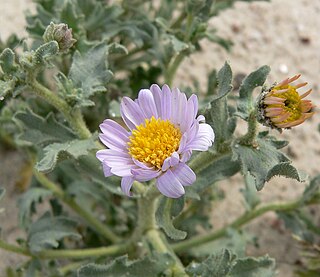
Leucosyris arida is an annual plant in the family Asteraceae, known by the common names arid tansyaster, desert tansyaster, and Silver Lake daisy. It is native to the very arid deserts of northern Mexico and the southwestern United States, and usually looks straggly and not very attractive. But in years with very heavy rainfall, it fills out and becomes rounded and bush like.

Pityopus is a monotypic genus of flowering plants in the family Ericaceae containing the single species Pityopus californicus, which is known by the common name pinefoot.

Solanum marginatum is a species of plant in the family Solanaceae known by the common names purple African nightshade and white-margined nightshade. It is native to Ethiopia and Eritrea, and it is known on other continents as an introduced species and sometimes a weed. It is a hairy shrub growing up to two meters tall. The large, distinctive, gray-green leaves are wavy along the edges, woolly on the undersides, and measure up to 18 centimeters long. The veins are white and lined with large, widely spaced prickles. The inflorescence contains several white flowers, hanging or nodding bisexual flowers and erect staminate flowers with large yellow anthers. The fruit is a yellow berry up to 5 centimeters wide.
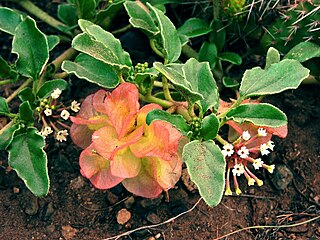
Tripterocalyx micranthus is a species of flowering plant in the four o'clock family known by the common names smallflower sandverbena and small-flowered sand-verbena.

Vicia pannonica is a species of vetch known by the common name Hungarian vetch. It is native to southern, central Europe and western Asia, and it is sometimes cultivated as an agricultural crop for use as hay and fodder. It may escape cultivation and grow as a casual roadside weed.

Allium fibrillum is a North American species of wild onion known by the common names Blue Mountain onion and Cuddy Mountain onion. It is native to the northwestern United States from eastern Washington and Oregon through Idaho to Montana. It is a perennial herb.

Blephilia hirsuta, commonly known as hairy wood-mint or hairy pagoda plant, is a species of herbaceous perennial in the mint family Lamiaceae. It is native to eastern North America.

Cardamine douglassii, the limestone bittercress or purple cress, is a perennial forb native to the eastern and central United States as well as the province of Ontario in Canada, that produces white to pink or purple flowers in early spring.

Ellisia is a genus of flowering plants in the forget-me-not family (Boraginaceae), containing the sole species Ellisia nyctelea. It is native to North America, where it is also known as Aunt Lucy, false baby blue eyes, and waterpod. The genus was named in honor of British naturalist John Ellis, a contemporary of, and correspondent to, Carl Linnaeus. It was published and described by Linnaeus, in his book Species Plantarum ed.2 on page 1662 in 1763.



















